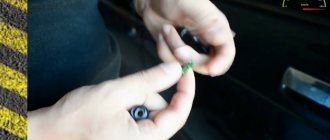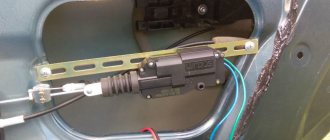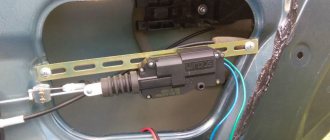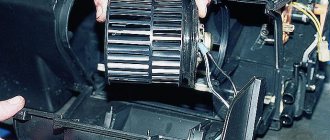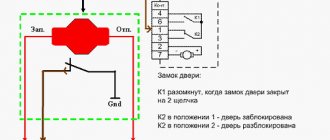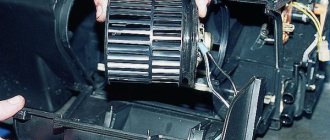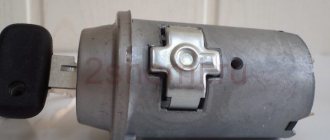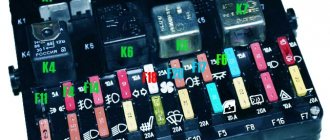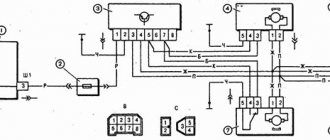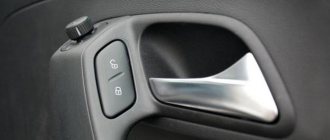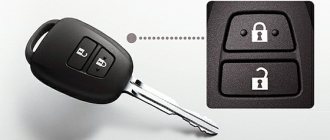| EXECUTION ORDER |
| 1. The central locking system uses two-way solenoids to lock and unlock the doors. Lock switches have two operating states: Locked and Unlocked. These switches operate a relay, which in turn supplies voltage to the door lock solenoids. Depending on what signal is sent to the relay, it changes its polarity, allowing both parts of the circuit to have a positive or negative voltage. |
| 2. Always check the electrical circuit protection first. Some vehicles use circuit breakers and fuses together. |
| 3. Switch the switches to both positions (Lock and Unlock) with the engine off. Listen to the faint click of the relay being activated. |
| 4. If you do not hear a click, check for voltage at the switches. If voltage is present, check the wires between the fuse box and the switches for shorts or opens. |
| 5. If voltage is present, but a click is not heard, check the switch for current continuity. Replace the switch if it does not conduct current in any of the positions (see table. Table of connection of the tester and conductivity of the main block of switches for the central locking system). |
| 6. If the switch is conducting but the relay does not click, check the wires between the switch and the relay. Reestablish the connection if there is a break in the circuit. |
| 7. If the relay receives power from the switch but does not send it to the solenoids, check that the relay case is properly grounded. If the relay case ground is OK, replace the relay. |
| 8. If the solenoids of all locks work except one, remove the trim panel from that door (see subsection 11.12) and check for voltage on the solenoid when the lock switch is turned on/off. There should be voltage on one of the wires when the switch is in the closed position; the second wire must be live when the switch is in the open position. |
| 9. If voltage is present at the inoperative solenoid, replace it. |
| 10. If there is no voltage at the inoperative solenoid, check the wire between the solenoid and the relay for an open. Warning Wires often break in the part of the wiring harness that is located between the body and the door (constant opening and closing of the door leads to the accumulation of fatigue in the wires and, ultimately, to wire rupture). |
Central locking on cars of the tenth family
The main function of the device is clear from the name: it is used to unlock and lock all car door locks at the same time. The operation of this device can be carried out both in conjunction with a car alarm and without it. The basis of the device is the VAZ-2110 central locking unit, which is a small circuit containing several semiconductor elements and electromagnetic relays. Instead of the latter, not relays, but transistor power switches can be used.
Despite all the advantages of central lock control, you should not trust it completely, especially if certain sins have been observed. In case of minor failures, one or more locks may not close completely. The reason for this may be a malfunction of the electric motor, the gearbox included in its composition, or the control system. To carry out even minor repairs, you need to know the structure and operating principle of the central lock.
Installing a car alarm on a VAZ 2110
A modern car alarm for the VAZ 2110, the installation photo of which is available on our website, requires preparatory measures, including:
- Removing the instrument panel secured with self-tapping screws, and individual interior decorations with clips and self-tapping screws
- Removing the lower part of the driver's panel located below the driver's feet
- Removing the lower half of the decorative steering wheel protection to make working with the ignition switch easier.
- When dismantling components and mechanisms, the removed chips and connectors must not allow these fittings to come into contact with metal, which can lead to a short circuit with the vehicle’s mass. It is more advisable to remember the installation location and insulate them with special tape.
Main components
The central lock (VAZ-2110) has the following components in its design:
- Semiconductor control unit for electric drives.
- The actuators are geared motors (4 in total - one for each lock, but if there is a drive to unlock the trunk, then five). These are small electric motors with gearboxes on the rotors.
- Limit switch that allows you to determine the state of the lock (installed in the gear motor mounted in the driver's door).
- Wires, connections, fuse.
The VAZ-2110 central lock can operate in several modes:
- All locks are activated when the driver's door is unlocked/locked.
- When arming and disarming a car alarm. Provided that the alarm and central locking control units have been connected.
- If there is a function for remote control of the central locking from the key fob. Such control systems have a fairly low cost and can be used on cars without an alarm system.
Design and principle of operation
The alarm control unit is the central element in the entire anti-theft system, interacting between all sensors and anti-theft subsystems. A control unit was built based on a central microprocessor that receives signals from sensors and control panels, processes information from them and makes decisions on further actions according to a pre-programmed algorithm of actions.
When installing an anti-theft system, security sensors are built into different parts of the car that detect vibrations, impacts and other external influences on the car. When information about an unusual situation is received from such sensors, an electronic signal is transmitted to the control unit. After processing this signal, the central processor turns on a sound and light alert about an attempted theft, transmits information to the control panel, and blocks those locks that were not closed at the time of operation.
When a coded signal is received from the remote control, the central processor can turn the car's security mode on or off, while locking or unlocking the car's doors and trunk.
The alarm control unit is equipped with a permanent storage device - a hard disk memory that can store information even in the absence of power. This is necessary so that in any situation all the standard settings and codes that are needed to disarm the car and arm it are saved.
The main causes of central locking failures
If the central locking of the VAZ-2110 does not work, the reason for this is some defect in the actuators - gearmotors. In the entire structure, they are the most vulnerable point, since they are subject to the greatest load. These devices move during operation, which speeds up the production of the elements included in their design.
But there is one important detail - VAZ-2110 cars were discontinued more than ten years ago, which already suggests that any of the cars will have problems associated with the “obsolescence” of elements. The wiring is destroyed, gear motors become unusable, even transistors in the control unit can fail over such a period due to frequent overheating. Therefore, it is necessary to carefully study all the symptoms of breakdowns and methods for eliminating them.
Central locking activators
It is with their help that the VAZ-2110 central lock is controlled. They are mounted in the doors and have a plastic body. Incidents of meltdown are rare, but they do happen. Especially if the device is subject to a large load or the motor is frequently triggered. In case of a physical defect (melting, destruction), the following symptoms appear:
- On the door in which the defective activator is located, the unlocking/locking function stops working.
- The fuse fails due to excessive loads on the supply circuit.
Causes of activator failures
Almost all activator components are made of plastic. It is quite durable and can withstand heavy loads. But there are also defects and lock malfunctions. In the latter case, there is a sharp increase in the load on the motor, the gears can break down and become disengaged. The lock will buzz, but the flags will not go down (or up, depending on the current state).
But such a manifestation of breakdowns can also be caused by incorrect installation. This is only the case if work has taken place relatively recently, directly or indirectly affecting the elements of the central lock. Failure to adjust the rods is the first sign that the entire system will not work correctly. The lock on which the adjustment is incorrect will not work, while the others function properly.
Problems in the operation of the activator electric drive
The central locking actuator is quite fragile and does not tolerate overload. The activator body, made of plastic, can easily melt if the frequency of door closing is excessively high. The duration of the control pulse also plays an equally important role. Try to always remember about the extreme fragility of the activator and not to load it during operation.
It is easy to guess that the activator is located in each individual door of the car. If the body of one of them melts due to overheating of the electric drive commutator, this becomes the cause of many problems:
- the activator on individual doors stops functioning;
- Constant overloads in a jammed electric drive cause the fuse to fail.
The actuator mechanism is entirely made of plastic. Gears can easily wear out and break during operation, or melt when the commutator overheats. As a result, when the central locking operates, characteristic creaking sounds are heard - a sure sign of imminent failure of the activators. Likewise, if the gearbox of the mechanism is humming, but the doors do not open or close.
Central locking control unit
Every motorist who has at least once encountered it knows where the central locking (VAZ-2110) is located. It is located under the central part of the dashboard, right on the floor. It is quite simple to distinguish it: the block is made of plastic, a wiring harness with a block at the end fits into it. After removing the cover from the block, you will see a small board with electromagnetic relays. It is this block that is responsible for the functioning of the entire system. And the reasons for its failure may be the following:
- If the activators malfunction or the load on them increases, the current in the power circuit increases. This leads to significant overloads, fuse failure, and destruction of printed wiring tracks. Under prolonged thermal loads, the soldering is destroyed, the mounting legs of the elements lose electrical contact with the entire circuit.
- Age plays a big role, so over time the contacts in electromagnetic relays can break down. Transistors do not last forever; they can also fail if overloaded.
- If the fuse burns out, the entire circuit does not work - the central locking does not respond to anything. The fuse is located in a special rubberized or plastic case, in a break in the red (sometimes pink) wire. Please note that you cannot install fuses of a larger rating, as this will lead to melting of the wiring and a fire.
- The plug connection of the control unit is one of the most vulnerable points. Next to him is the stove (heat source), and the driver’s shoes, which may have dust, dirt, and water on them. All this together causes oxidation to appear on the block. You can get rid of it using special solutions or sprays (WD-40 and the like). If the condition of the pad leaves much to be desired, it is easier to replace it completely.
Control unit electronics
The VAZ-2110 central locking circuit consists of semiconductors and electromagnetic relays. But the latter are not used in all central locking models. After all, it is much more efficient to use transistor switches; they work on the principle of a relay, but there is no physical stress. As a result, mechanical wear is completely eliminated. But there is still a chance of breakdown of semiconductor elements.
If there is a breakdown, the central locking system on the top ten will either be constantly set in motion, or will completely stop responding to action. To check the operation of the control unit, it is necessary to connect alternately to the yellow and red wires of the driver's door gearmotor. Preferably directly on the connection block to the control unit. If the flags go up and down normally, then there is no point in blaming the electronics for failure; you need to look for the cause in other components.
Breakdowns in the wiring
The next important element of the entire system is electrical wiring. The operation of the central lock depends on its condition. If there are abrasions on the wires or cuts, this will inevitably lead to either spontaneous activation of the activators or to their inoperability. Most often, the wiring is destroyed at the bends - between the door and the body. To check the integrity, you need to test each wire separately. Just remember to turn off the power, otherwise you will damage the multimeter.
Limit switch malfunctions
The limit switch allows the control system to understand in what position (locked or unlocked) the door is currently located. With its help, a signal is sent to unlock and lock the VAZ-2110 central locking relay. In the event of destruction, a picture may be observed in which a signal to unlock is received, but a signal to lock is absent. To make repairs, you need to completely change the driver's door activator. These elements cannot be repaired, so in case of breakdowns, only complete replacement will help.
The VAZ-2110 central lock is considered a fairly safe device for the owner of this car. Keeping pace with progress, a person strives to be in time everywhere. This type of transport, such as a car, has long become not a luxury, but a means of transportation. According to statistics, every second person drives a car.
1. Mounting block. 2. 8 A fuse. 3. Control unit. 4. Right front door locking motor. 5. Motor reducer for locking the right rear door. 6. Left rear door locking motor. 7. Motor reducer for locking the left front door with a contact group. A - to power supplies; B - conventional numbering of plugs in the control unit block; C - conventional numbering of plugs in the blocks of geared motors for locking locks.
Today, the products of the domestic automobile industry are not in great demand, since foreign cars dominate the market. But not everyone can afford a foreign car. Therefore, people buy cheaper domestically produced vehicles. One of these cars is the VAZ 2110, which was distinguished by its stable performance, low cost of repair and easy operation.
How the central lock works
Central locking is a system that, when given a certain command, performs the function of opening or closing an object. For ease of use, this operation is performed remotely. Some car enthusiasts choose the function of closing all doors after a certain period of time. It is very convenient for those cases when the driver does not have time or forgets to close the car door.
As a rule, using a long-range remote control you can control both the trunk and the hood, close and open the windows. The most common way to control the remote control is by pressing one button, after which all the locks on the car are activated. If the remote control does not work for some reason, then you need to insert the key into the door lock and turn it clockwise.
If an accident occurs, the car's security system is activated automatically and all locks open. At the heart of the central locking mechanism are incoming sensors located in the structure itself. These are microswitches and door switches (limit switches), actuators and a control unit.
Selecting a security alarm for installation on a domestic car
The function of remotely closing and unlocking all car doors is mandatory for all types of modern anti-theft alarms. It is impossible to install an alarm without a central lock, so car owners are forced to install a central lock before purchasing a security system.
The trade offers motorists hundreds of models of anti-theft alarms in a wide price and functional range.
When choosing a car alarm for installation on domestic cars, the main selection criteria for car owners are:
- Affordable security system price. Experienced car enthusiasts do not buy the cheapest anti-theft alarms, doubting their durability and quality of work. Most Russian drivers prefer to buy car alarms from the middle price range.
- System functionality. Ordinary owners of VAZ models consider the car alarm to include a remote key fob, two or three sensors, a siren, and connection cables as a sufficient set of options.
- Possibility of self-installation. To implement this requirement at the purchase stage, you need to be interested in the complexity of the electronic control unit for the security system, detailed diagrams and instructions for connecting the anti-theft alarm. When installing it yourself, minimal disruption to the standard electrical wiring is desirable; it is not recommended to interfere with the operation of existing mechanisms.
Owners of VAZ-made models do not need to worry about the difficulties of flashing factory protections or bypassing standard immobilizers. However, experts do not recommend that novice car tuning enthusiasts begin work by independently installing security systems equipped with:
- remote engine start (remote engine start based on temperature, timer);
- coded dialogue communication system, GSM modules;
- numerous additional options (starting from a smartphone, turning on heaters, air conditioners).
If you want to install a full set of security options on a VAZ model, you will have to contact a specialized service, where they can install additional equipment.
The easiest way to install a simple car alarm with a minimum set of functions on your own.
On sale you will find dozens of simple anti-theft car alarms that are available for self-installation on VAZ models; all you have to do is choose the ones that are suitable for the price and set of functions.
Possible problems with the locking system
As we know, any equipment fails sooner or later. And the central locking on the VAZ 2110 is no exception. There are a number of problems that manifest themselves in the operation of this system. Many motorists inadvertently destroy their car's security system. The driver should not give a long or rapid impulse when requesting a door to be opened or closed.
Central locking diagram for VAZ 2110
This action can damage the activator with which the closing device operates. When a long pulse is applied, the collector of the activator electric motor heats up very much. In this regard, the brush holder begins to melt and it may jam. After this, the activator will need to be replaced.
A fuse protects the central locking circuit. It is from this point that they begin to search for faults in the operation of the entire circuit. It is located inside the car, behind the fuse box. According to the diagram, it is located at the break of the pink wire (in insulation). Under the driver's mat there is a wire with a plug connector, which accumulates moisture and oxidizes. The power supply to the activator is lost.
The modular central locking unit may break. You should check its functionality by applying voltage from the battery to the module connector contact. The gear activator gears are made of plastic. Such parts are subject to wear and tear and this is a mechanical failure.
But the solenoid is considered the weakest point of the central lock; most often it is the one that fails. The electromagnet is controlled via a switch. When opening and closing doors, the life of the solenoids is calculated for approximately 10 thousand operations. After this number of switchings, malfunctions begin. The repair is simple: you need to replace the solenoid itself.
Where is the alarm unit located?
The block of the anti-theft complex can be located anywhere in the car, because when installing a security system, installers are guided by the rule: the block is placed in a place inaccessible to intruders, otherwise the anti-theft system will not be able to perform its function.
Locate car alarms in typical locations where they are most often installed by professionals. The alarm is usually installed and placed inside the cabin.
To find an alarm in your car, it is recommended that you first look under the dashboard. Automakers often leave enough space underneath to install additional equipment. This installation method is also convenient because power is supplied to the dashboard from the battery.
In some cases, the alarm unit is installed under the inner trim of the driver's door. You can also find the unit under the front passenger door interior panel. You can look under the panel located near the handbrake. Installers rarely install an anti-theft system near the clutch, since this mechanism operates quite often and can damage the anti-theft wires. For the same reasons, the anti-theft system unit is rarely installed in the engine compartment.
You can look for the block under the driver's seat. This installation location is sometimes chosen by motorists who install anti-theft devices themselves. Professional installers will not install the unit in such a place.
If the car is equipped with standard anti-theft electronics, the location of its installation is described in the car's operating instructions.
What does it look like
The power supply can have a very different appearance. In most cases, it looks like a small rectangular box made of black plastic with a lot of wires attached to it.
Installation recommendations
When purchasing a VAZ 2110 at a specialized car dealership, there is a possibility that the functionality of the basic security system will be limited. That is, only doors (sometimes not even all) can be locked with a remote control or key. For car safety, drivers install alarms on all opening parts of the car.
To do this, you can use the services of specialists from a service station, or you can do the installation yourself. If you know the circuits of the central locking and the operation of the electronic device itself, then you can easily install a lock on any part of the car. Specialists of various levels use instructions when installing an alarm system on a car.
The VAZ 2110 central locking diagrams and the rules for installing the security system are included with the alarm system. Despite the fact that such a simple but important system as central locking can fail, you will not meet a driver who would not praise it. When purchasing a car, everyone looks at the package, which should include an electric alarm system (or central locking).
Many cars do not have an alarm system, but have central locking, which was installed at the factory. There is no big difference, but the convenience of the presence of a centralized blocking system is appreciated. This is better than waiting for passengers to get out of the car, then closing all the doors from the inside and closing your own when exiting. It is convenient to press one button on the control panel so that all doors close/open at once.
A problem with the system is possible when the battery in the key is dead. But this is not a very serious “trouble”, which can be solved by simply replacing the power source. The central locking diagram clearly proves the simplicity and uniqueness of the device.
Signal and central locking, VAZ-2110
This review discusses how to connect an alarm system to the central locking of the following cars: VAZ-21099, as well as 2110 and 2115. There are three standard connection schemes: for central locking controlled by negative polarity, positive and variable. But different cars have their own nuances. Sometimes it is necessary to add a fuse to the “+12 Volt” wire, sometimes, on the contrary, this is not required. VAZ locks, in turn, belong to the simplest type, the first. But the standard scheme published on the Internet is not suitable for them.
Who can you trust to install an anti-theft device?
There are the following options for installing an alarm on a VAZ 2110:
When installing this security system yourself, you must have certain knowledge and skills in the field of electronics and car design. The same requirements apply to friends, colleagues and acquaintances involved in these technological operations. The most successful option would be to shell out 2 – 2.5 thousand rubles and contact specialists in order to avoid failure or incorrect installation of fairly expensive equipment.
Some technical features of choosing a car alarm for a VAZ 2110
The anti-theft device must be selected with power outputs for direction indicators, repeaters and side light indicators. Such outputs are not suitable for low currents; there is a high probability of wiring burnout. If the system is structurally equipped with one power wire, then we select the side lights as the alarm indicator; if there are two wires, we connect the turn indicators and their repeaters on the wings. Such a security device must also have power outputs for the door locks. A pulse value of 0.8 s is sufficient for a VAZ 2110. A good car alarm for a VAZ 2110, a photo of which is posted on our website, should have different buttons for turning on and off the “anti-theft”; it is recommended to select a system with a dynamically changing radio pulse code, which negates the scanning recording the code of car opening by car thieves. We choose an ordinary, autonomous type of sound siren; for security alarm systems with reverse scanning, an isolated monotone siren with a power of 20 W is required.
LCD key fob for car alarm StarLine
Tools required to install a car alarm on a VAZ 2110
These tools include:
- Phillips head screwdriver
- Wrench or 10mm socket with wrench for ease of use
- A mechanic's knife (scalpel) and a lighter for stripping wiring
- Black impregnated fabric insulating tape with a fresh sticky surface
- Double-sided tape.
- Foam rubber, which is necessary to protect the control unit from mechanical damage and shock absorption during movement, is preferably dark in color
- Multimeter and skills to use it
- Selected car alarm for VAZ 2110, instructions for use are included
Selecting a location for installing a security device
During this procedure, fulfill the following conditions:
- Find a secret place to install the control unit in the car
- Do not install the control unit near heat sources and liquid filling equipment (heating and air conditioning systems)
- Do not install the control unit near active devices for receiving and transmitting radio waves (stations, auxiliary equipment, power wiring, etc.)
- The main requirement is that the wires are long enough to connect to the necessary devices.
- The control unit should be located as secretly as possible, in a hard-to-reach place
Car alarm control unit
We believe that it is better to attach the control unit to the instrument panel, having previously covered it with foam rubber cloth and leave open spaces for connectors.
Let's make the alarm system and central locking together
Any modern alarm unit is equipped with two relays connected to the central locking control unit. One relay is opening, the second is locking, and the circuit in the general case looks like this:
Control of central locking by supply of “mass”
In our case, the green and white cords coming from the signaling unit will be required, as indicated in the diagram. However, they will not be the only ones needed. We will connect the relay contacts to breaks in the standard wiring. This means there will be not 2, but 4 cords.
The cause of the malfunction of the central locking VAZ 2110
How quickly a person gets used to everything good. It would seem like a central lock
, such a small thing, but to what extent...
Operation of the central locking relay VAZ 2110
This relay can be used in any car, the advantages are ease of installation, as well as low cost of components.
Connection diagram for VAZ central locker
Take another look at the diagram published in the first chapter. We will connect the relay to the gap in the white and brown wires going from the microswitch to the central lock control unit. And it is obvious that it is easier to break these wires near the 8-pin connector. The same one shown at the beginning.
To avoid any questions, we will show you what should happen as a result:
Connection diagram, central lock VAZ
The common contacts are connected to the wires coming out of the microphone. The white cord continues with the brown wire coming from the door, and so on. Normally closed contacts are also used, along with normally open ones. These are the features of connecting to the VAZ central locking system.
An approximate sequence of actions performed by the installer:
- Make and lay a 4-core cable running from the signaling unit to the 8-pin connector;
We have given this sequence to emphasize once again that the relays are switched on between the microphone and the central lock control unit. There is no need to connect any additional devices. As a result, the alarm system will be able to control the state of the locks.
Remember that installation is performed by removing the negative terminal from the battery.
All wires added to the car structure must be protected (use heat-resistant tubes or electrical tape). Twisting is not the worst method to connect two wires. But it's even better to use soldering.
An interesting nuance from practice
It would seem that if a person has experience working with electrical equipment, he can do everything according to the instructions given. As a result, if no mistakes are made, you may encounter an interesting phenomenon. Instead of closing, there will be a short-term locking followed by opening. And vice versa. What to do in this case?
Take a look at what exactly may be present in some of the configurations:
Cheaper - no driver actuator
The driver's door may not have an actuator. And then, it is useless to connect the signaling system to the control unit. There is no actuator, which means there is no one to close or open the door and move the microphone lever. Let's say the locks are closed, and then we remove ground from the brown wire and we get the following: the white wire is on ground, unlocking occurs.
We note the following: installation can only be carried out when you are sure that there is an actuator in the driver's door.
There were configurations where only a microswitch was installed. There is no need for arrogance here - adding an actuator will be difficult, since standard wiring must go to it. As you understand, it may not be available from the factory. And it’s unclear what to do then.
There remains one unanswered question - where exactly the central locking control unit is located. In these VAZ models, if there is a central locking system, then there is also a control unit. And it is located under the torpedo cover, next to the driver, on the right:
VAZ-2110, BU TsZ
We remove the “beard” of the torpedo and look at what is on the upper right. On the same plane with the radio connector there are two boxes attached - the one we need, as well as the immobilizer (if there is one).
We would be lying if we did not say that in reality there is another option for installing the alarm. Standardly, only two power cables go to the actuators. Having a power outlet equipped with a fuse, these cables are connected directly to the alarm relay. This option, as you might guess, is not recommended. Imagine what would happen if the alarm system broke. The central lock must remain, but in this case this will not be done. Happy connection!
Lock connection diagram
Having a power outlet equipped with a fuse, these cables are connected directly to the alarm relay. We would be lying if we did not say that in reality there is another option for installing the alarm.
The approximate price for a regular central locking activator with 2 terminals, a two-wire electric lock, is RUB.
For each door, repeat the steps VAZ central locking To better understand the idea of connecting an alarm, it is still worth studying the instructions included with it.
Personal experience is described here, so you always have the opportunity to do something better, more beautiful, more convenient, and so on. So, in the diagram, the index X2 indicates the six-pin control connector of the BUBD, which was mentioned at the beginning.
It is much easier to install electrical activators by connecting everything to a unit with a remote control function. Clamps Some important points Before installing the central locking system, be sure to remove the terminals from the battery. Such a budget central locking control unit can only perform a service function. Many of these risks can be reduced to zero if you take certain precautions: - It is not recommended to park your vehicle in areas where there is electromagnetic interference near power lines, relays, radio and television stations, neon signs, etc.
You can see the VAZ central locking diagram in the picture. The central locking functions operate remotely at a distance of up to 10 meters. Single-wire central lock control circuit. Let's look at how to connect the central locking, as well as installing a simple remote control. It will cost more, but it turns out to be 3 in one: door locking, connection of a security alarm and automatic raising of lowered windows.
Do-it-yourself central locking installation
You can see the VAZ central locking diagram in the picture. Route the wiring from the electric motor to the control unit. In idle mode they have little positive potential. And this, you see, also costs a lot.
It is by checking the fuse that the diagnosis of central locking malfunctions begins. Control signals from the alarm system to the central locking system will conflict with the information received from the limit switch installed in the driver's door. This eliminates their mechanical wear. Having a power outlet equipped with a fuse, these cables are connected directly to the alarm relay. The unit in question can be implemented not only into a standard system with minus or plus control, but also into a central locking system with a vacuum drive. How to connect an alarm
